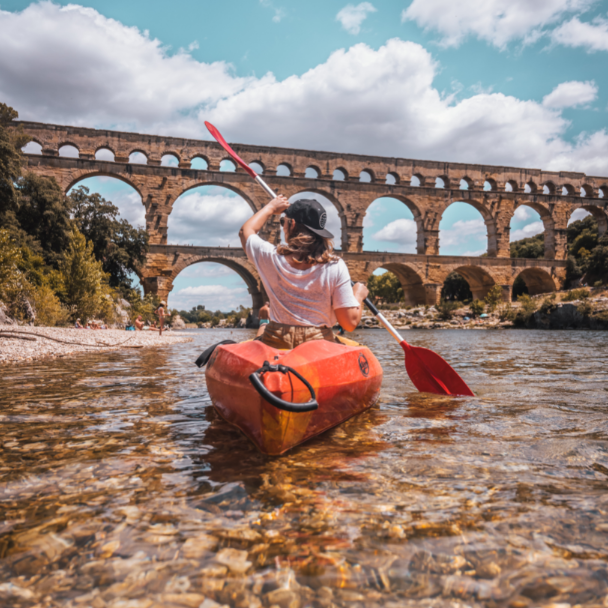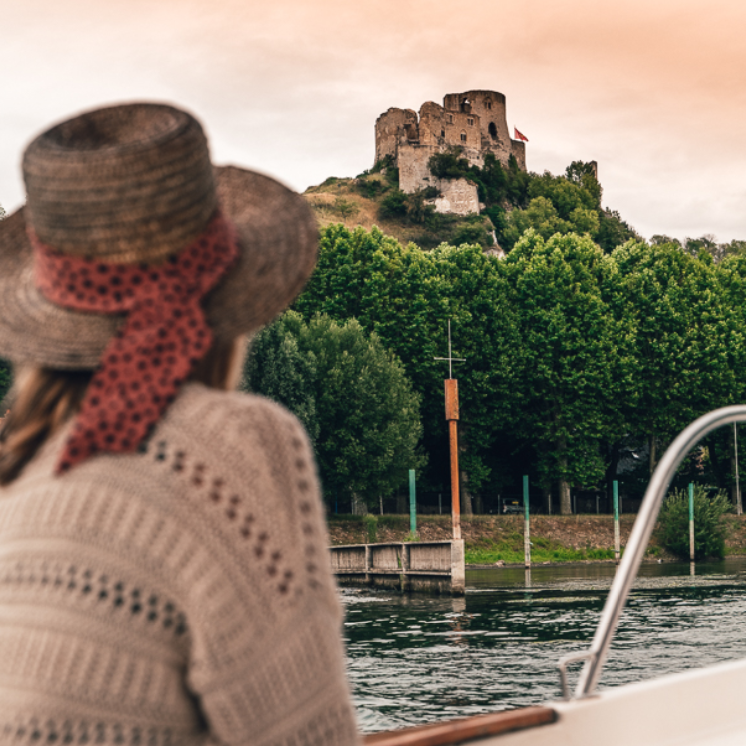With 8,500 km (5,281 miles) of waterways, France has the longest river network in Europe. It’s certainly more than enough to inspire you to want to discover it afloat. Admire the Pont du Gard from a canoe, float up the Dordogne and get up close to riverside castles, pass beneath the arcades of the Chateau of Chenonceau, or crisscross the Ill in Alsace in a flat-bottomed boat like the boatmen of yesteryear. Here are 8 watery trips, by canoe, rowboat, or traditional flat-bottomed boat...
Get a surprising perspective of the Château de Chenonceau from a canoe

Right bank or left bank? Well, neither! Hop into a canoe and set sail for the arcades of the castle of Chenonceau and visit this most aquatic of the Loire castles, built overlooking the river Cher. It’s an unusual way to admire the five-arch, 60-meter-long, gallery that spans the river. Once a ballroom which hosted the festivities of Catherine de Medici, it has also served as a crossing point for the Resistance during the Second World War. The right bank was in the occupied zone and the left bank was in the free zone. The memory of those dark years seems so far away on sunny days that light up the Renaissance facades of the castle of Catherine de Medici.
Rowing through the Gorges du Verdon

Embark on a mini-canoe cruise in the Gorges du Verdon for a hint of the American Midwest. From a boat you can see the landscape gradually taking shape, as you advance slowly between the tall, greenery-topped cliffs where vultures, hawks and even golden eagles circle above. Watch for the openings in the walls which lead to mysterious labyrinths - the caves of the Gorges de Baudinard have served as a refuge since prehistoric times. When you arrive at Lake Sainte-Croix, you’ll find the cliffs are lined with mosses and ferns which highlight the brilliant luminosity of this area: a turquoise ocean awaits you!
Cross beneath the Pont du Gard by canoe

You can stand on top of this almost 2000-year-old aqueduct bridge. Or, hop into a canoe to really appreciate the size of the Pont du Gard. At a whopping 49 meters high, it is the tallest Roman aqueduct bridge in the world. It’s also a masterclass in strength and is the only ancient world three-storey bridge still standing. In Roman times, water flowed across the top to supply fountains, baths and rich mansions. Today it flows only down the river but provides an incredible observation post to admire the elegance of this building that continues to defy the years.
Descend the Dordogne River at your own pace

Did you know you can explore the castles of Dordogne from the river? From the water, the exceptional history of the region is gently revealed, villages of mellow blonde stone, buildings topped with slate roofs, castles that seem to have appeared from fairy tales, such as Beynac and Castelnaud which houses the museum of war in the Middle Ages. In La Roque Gageac, the houses of the gabariers, the boatmen of the old days, take on a golden hue and you’ll spot an incredible tropical garden planted with banana and palm trees where papyrus reeds flourish at the foot of the cliff. Transfer to the riverbank and climb the 140 steps that lead to the troglodyte fort – you’ll get a beautiful view of the river Dordogne from above!
Try a canoe-tent on the banks of the Loire

The Loire is the longest river in France (1,020 km including 900 km of navigable waterways) and it’s the last wild river in Europe which makes it the ideal playground to test a combo trip in a canoe with a tent! In summer months its best to wait until the end of the day to sail along the water to witness the river mirror and capture the colours of the sunset. On the riverbank, pick a strip of sand under the trees and set up your tent for the night! While your dinner simmers on a stove, contemplate the starry sky, and promise yourself to wake up at dawn to observe the bird life – it’s well worth it.
Learn to row near Fontainebleau

In Fontainebleau, between visits to the castle and the forest, discover the art and vocabulary of rowing. Either solo or in pairs, you will practice on land before you move onto the river. Stretch your arms, push your legs out, concentrate – then let yourself relax. Enjoy the view of 19th century holiday homes along the lush green banks, this river at the gateway of Paris is truly mesmerizing.
Make like a boatman in a flat-bottomed boat in Alsace

These boats were used to transport goods when waterways were safer than roads. Today, flat-bottomed boats are used for fishing or leisure. Led by Patrick the boatman of the Ried, you’ll see the reed-lined banks flow by and spot wild birds including curlews, marsh harriers and owls. In Muttersholtz, near Sélestat, Patrick is reviving the tradition of these long wooden boats which are made from fir trees and Scots pine from the forests of the Vosges and Haguenau. Discover the unique and mysterious craft of boat-making using reed seals and marsh moss for waterproofing.
Dreaming on the Seine in Normandy

Her winding curves inspired the Impressionists and kings! When you travel along the river Seine, it’s like going back in time. In Les Andelys, the flag of Normandy still flies even though the citadel has lost some of its splendour. At the foot of Château-Gaillard, once the castle of Richard the Lionheart, it’s easy to dream of the extraordinary destiny of this knight king who reigned over both England and the Duchy of Normandy. Built in 1198 on a cliff at the curvature of the river, the castle resisted a siege by the King of France for six months before falling. Not a cheerful ending, but even so, when it reveals itself at the bend of a curve of the Seine it is an exceptional sight.
Learn More 4 ways to experience slow tourism in France
By Anne-Claire Delorme
Globetrotting journalist [email protected]








